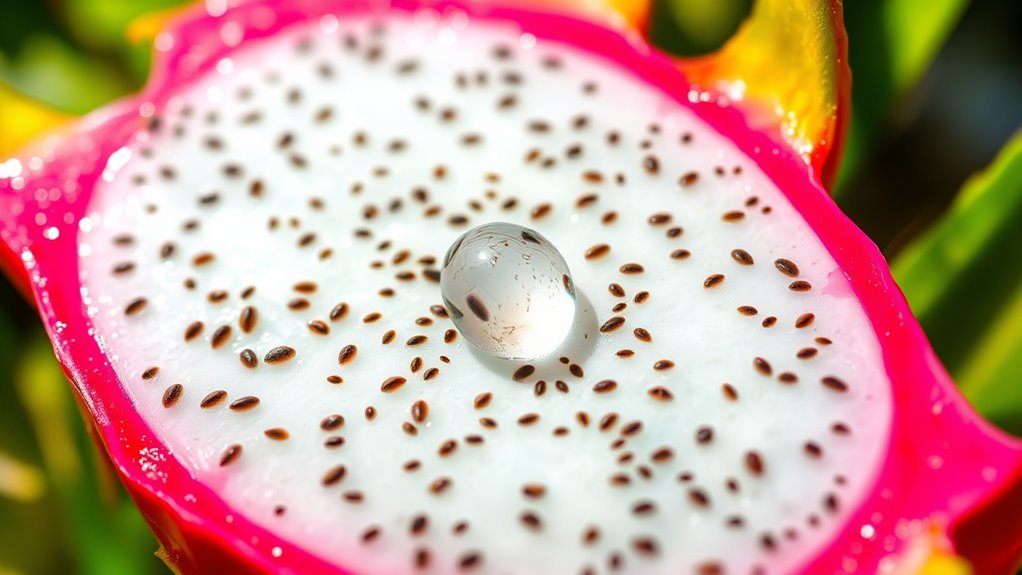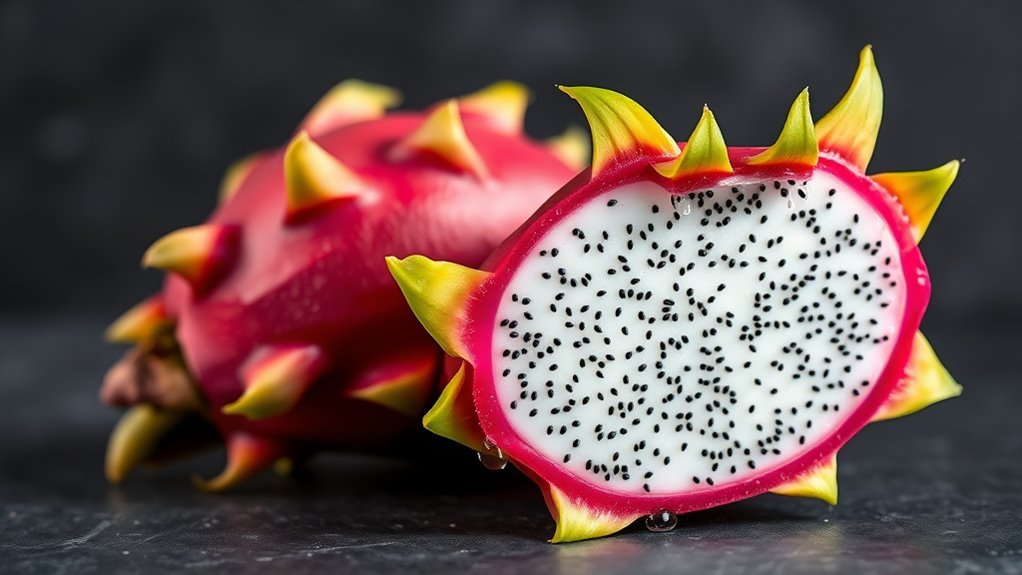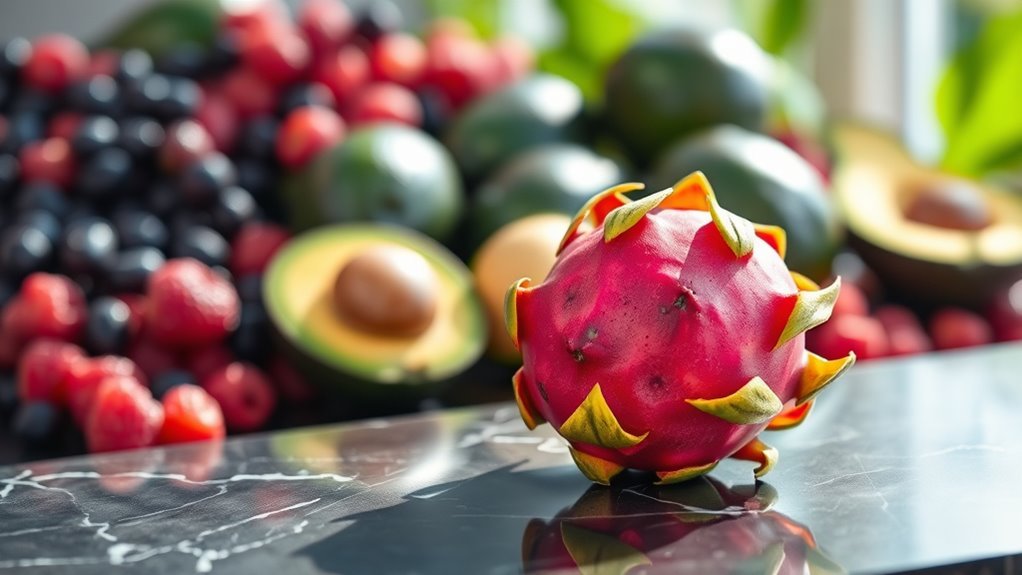Yes, dragon fruit can be included in a keto diet, but portion control is key. With about 10 to 14 grams of carbohydrates per 100 grams, depending on the variety, it’s important to monitor your intake. The high fiber content can help reduce net carbs, making it a potential fit for keto when enjoyed in moderation. Pairing it with fats like coconut cream can enhance its compatibility. There’s much more to explore about its benefits and creative uses.
Nutritional Overview of Dragon Fruit

When you take a closer look at dragon fruit, you’ll find it’s a unique tropical fruit packed with a variety of nutrients. This vibrant fruit comes in different dragon fruit varieties, including the white-fleshed, red-fleshed, and yellow-skinned types, each offering distinct flavors and textures. Rich in antioxidants, vitamins C and B, and fiber, dragon fruit supports your immune system and digestive health. Its culinary uses are diverse; you can enjoy it fresh, blend it into smoothies, or incorporate it into salads for a colorful twist. With its low calorie count and revitalizing taste, dragon fruit can be a delightful addition to your diet, providing both nourishment and a sense of culinary adventure.
Carb Content: A Closer Look

When considering dragon fruit on a keto diet, it’s essential to examine its carb content closely. This tropical fruit typically contains around 13 grams of carbohydrates per 100 grams, which can impact your daily intake. Additionally, its glycemic index is relatively low, suggesting it may not cause significant spikes in blood sugar levels.
Carb Count Breakdown
Understanding the carb content of dragon fruit is essential for anyone following a keto diet. When considering different dragon fruit varieties, you’ll find that their carb counts can vary, impacting your keto friendly recipes. Here’s a breakdown of the carb content per 100 grams of common dragon fruit types:
| Dragon Fruit Variety | Total Carbs (g) | Net Carbs (g) |
|---|---|---|
| White-fleshed | 13 | 9 |
| Red-fleshed | 11 | 7 |
| Yellow-fleshed | 12 | 8 |
| Pink-fleshed | 10 | 6 |
| Black-fleshed | 14 | 10 |
As you can see, choosing the right variety can help you stay within your carb limits while enjoying this unique fruit.
Glycemic Index Insights
Although dragon fruit is often praised for its vibrant appearance and unique taste, it’s important to evaluate its glycemic index (GI) for those on a keto diet. The GI measures how quickly a food affects your blood sugar levels. Dragon fruit has a relatively low GI, typically around 48, meaning it’s less likely to cause a rapid glycemic response compared to higher-GI fruits. This makes it a more suitable option for keto enthusiasts seeking to manage their blood sugar. However, moderation is key; even low-GI foods can contribute to your overall carb intake. So, while dragon fruit can fit into your diet, keep an eye on portion sizes to maintain your keto goals without compromising your freedom to enjoy diverse flavors.
Comparing Dragon Fruit to Other Fruits

While many fruits are celebrated for their health benefits, dragon fruit stands out due to its unique nutritional profile. Unlike common tropical fruits, dragon fruit is low in carbs, making it a keto-friendly option for those watching their carbohydrate intake. In fruit comparisons, dragon fruit offers a blend of antioxidants and vitamins without the sugar spike seen in many other exotic fruits. Its high fiber content serves as an excellent source of dietary fiber, promoting digestive health. When exploring low carb options, dragon fruit provides a revitalizing alternative that can be easily incorporated into various diets. By choosing dragon fruit, you can enjoy its nutritional benefits while still adhering to your dietary goals.
The Role of Fiber in Dragon Fruit
Dragon fruit’s low carb profile is just one of its many advantages, particularly when it comes to its fiber content. This tropical fruit is packed with fiber, offering numerous fiber benefits that can enhance your overall health. Eating fiber-rich foods like dragon fruit can promote digestive health, helping to keep things moving smoothly in your gut.
Here’s a quick breakdown of fiber content and its benefits:
| Fiber Source | Benefits |
|---|---|
| Dragon Fruit | Aids digestion |
| Insoluble Fiber | Promotes regularity |
| Soluble Fiber | Supports heart health |
| High Fiber Foods | Reduces cravings |
| Balanced Diet | Maintains overall health |
Incorporating dragon fruit into your diet can be a tasty way to boost your fiber intake and support your digestive system.
How Dragon Fruit Fits Into a Keto Diet
If you’re following a keto diet, understanding how dragon fruit fits into your meal plan is essential. Dragon fruit is low in calories and high in fiber, which can help you feel full without kicking you out of ketosis. While it has more carbs than some other keto-friendly fruits, you can still enjoy it in moderation. Incorporating dragon fruit into keto friendly recipes, like salads or desserts, can add variety to your meals. Additionally, you can whip up delicious dragon fruit smoothies that blend well with low-carb ingredients like spinach or coconut milk. Just keep track of your daily carb intake, and you can savor the unique flavors of dragon fruit without guilt.
Health Benefits of Dragon Fruit
Dragon fruit boasts a nutrient-rich profile, providing essential vitamins and minerals that support overall health. Its antioxidant properties may help combat oxidative stress, which is linked to various chronic diseases. Incorporating dragon fruit into your diet can offer these benefits while keeping your meals interesting and flavorful.
Nutrient-Rich Profile
While many fruits can be high in sugar, dragon fruit stands out with its unique nutrient-rich profile, offering a variety of health benefits. This exotic fruit is not only visually appealing but also packed with essential nutrients that contribute to overall well-being.
Here are some key highlights of dragon fruit’s nutrient density:
- Low in calories: Perfect for those watching their weight.
- Rich in fiber: Aids digestion and helps maintain a healthy gut.
- High in vitamin C: Supports immune function and skin health.
- Contains healthy fats: Specifically, omega-3 and omega-6 fatty acids, which are good for heart health.
Incorporating dragon fruit into your diet can boost your nutrient intake while keeping your carb count in check. Enjoy the freedom of healthier choices!
Antioxidant Properties
One of the most compelling aspects of dragon fruit is its impressive antioxidant properties, which play a crucial role in promoting health. Packed with antioxidants like vitamin C and betalains, dragon fruit provides significant antioxidant benefits that can help combat oxidative stress in your body. This stress, often linked to chronic diseases, highlights the importance of including foods rich in antioxidants in your diet. By consuming dragon fruit, you might improve your overall health and reduce the risk of conditions like heart disease and certain cancers. The health implications are clear: embracing this vibrant fruit can enhance your wellness journey while enjoying its unique taste. So, why not explore the delicious potential of dragon fruit?
Portion Control: Enjoying Dragon Fruit on Keto
To enjoy dragon fruit on a keto diet, it is essential to practice portion control, as this exotic fruit, despite its unique flavor and nutritional benefits, does contain carbohydrates. Understanding appropriate portion sizes can help you enjoy this vibrant fruit without derailing your keto goals. Here are some serving suggestions:
Enjoy dragon fruit on a keto diet by practicing portion control to stay within your carb limits while savoring its unique flavor.
- Stick to a quarter to half of a medium dragon fruit per serving.
- Pair it with high-fat foods like coconut cream or nuts to balance the carb content.
- Monitor your daily carb intake, ensuring dragon fruit fits within your limits.
- Consider using dragon fruit as a garnish or in smoothies to keep portions manageable.
Creative Ways to Incorporate Dragon Fruit
Incorporating dragon fruit into your keto diet can be both fun and flavorful, especially when you get creative with how you use it. Try blending it into smoothie bowls for a vibrant breakfast, or toss it into dragon fruit salads for a rejuvenating lunch. You can even whip up exotic desserts like dragon fruit sorbet or use it as a tropical snack paired with nuts. Consider adding it as a colorful garnish on keto-friendly dishes, or mixing it into fruit salsas for an exciting twist. Don’t forget to sprinkle it on breakfast toppings like chia pudding or yogurt, bringing a burst of color and flavor to your meals while keeping your diet interesting and enjoyable.
Potential Side Effects and Considerations
While dragon fruit can be a nutritious addition to your keto diet, it is essential to be aware of potential side effects and considerations. Some individuals may experience:
- Dragon fruit allergies: Though rare, allergic reactions can occur, leading to symptoms like hives or itching.
- Digestive issues: Consuming large quantities may cause bloating or diarrhea due to its high fiber content.
- Blood sugar levels: While generally low in sugar, moderation is key to avoid unexpected spikes.
- Medication interactions: If you’re on certain medications, consult your healthcare provider to guarantee there are no adverse effects.
Being informed empowers you to enjoy dragon fruit while minimizing any risks. Always listen to your body and adjust your intake as needed.
Final Thoughts on Dragon Fruit and Keto
When considering dragon fruit in a keto diet, it’s crucial to look at its nutritional profile and carb content. While it offers some health benefits, its carbohydrate content might impact your daily limits. You can still enjoy it in moderation if you plan your meals carefully.
Nutritional Profile Overview
Dragon fruit, with its striking appearance and unique flavor, offers a fascinating nutritional profile that can influence its compatibility with a ketogenic diet. You’ll find that various dragon fruit varieties, such as Hylocereus undatus and Hylocereus costaricensis, provide diverse culinary uses while delivering essential nutrients. Here are some highlights of its nutritional benefits:
- Low in calories, making it a light addition to meals
- Rich in antioxidants, supporting cellular health
- Contains fiber, aiding digestion and satiety
- Provides vitamins C and B, promoting overall wellness
While dragon fruit can add color and flavor to your dishes, it’s essential to take into account your individual carb goals on a keto diet. Balancing enjoyment and dietary needs is key to maintaining your lifestyle!
Carb Content Analysis
Understanding the carb content of dragon fruit is essential for those on a ketogenic diet. Dragon fruit contains about 13 grams of carbohydrates per 100 grams, which might seem high compared to other keto-friendly fruits. However, it also provides fiber, reducing its net carb count to approximately 9 grams. This makes it a more viable option among carb sources when consumed in moderation. If you’re looking for variety in your diet, dragon fruit can be a revitalizing addition, but keep in mind portion control. Ultimately, while it may not be the lowest-carb fruit available, it can still fit into a well-planned keto lifestyle, especially if you balance it with other lower-carb foods.
Incorporating in Diet
Although you might be cautious about adding dragon fruit to your keto diet due to its carb content, there are ways to incorporate it without compromising your goals. By using dragon fruit wisely, you can enjoy its unique flavor and health benefits. Here are some ideas for keto-friendly snacks and dragon fruit recipes:
- Blend it into smoothies with low-carb ingredients like spinach or coconut milk.
- Use it as a topping for chia pudding or low-carb yogurt.
- Make a revitalizing dragon fruit salad with avocado and lime.
- Create dragon fruit-infused water for a flavorful hydration boost.
Frequently Asked Questions
Is Dragon Fruit High in Calories?
When you think about caloric content, you might wonder if dragon fruit’s high or low in calories. It’s relatively low, with about 60 calories per 100 grams, making it a great option for those watching their intake. But don’t forget its nutritional benefits! Packed with vitamins, minerals, and antioxidants, it supports your health while providing a revitalizing taste. So, enjoy dragon fruit without worrying too much about its caloric content!
Can Dragon Fruit Cause Allergic Reactions?
Yes, dragon fruit can cause allergic reactions, though it’s relatively rare. If you have a history of allergies to other fruits or plants, you might want to be cautious. Symptoms of dragon fruit allergies can include itching, hives, or gastrointestinal issues. It’s always a good idea to introduce new foods slowly and monitor your body’s response. If you suspect an allergy, consult a healthcare professional for personalized advice and guidance.
How Should Dragon Fruit Be Stored?
Imagine you’ve just bought a vibrant dragon fruit, enthusiastic to enjoy its unique taste. To maintain ideal freshness, it’s essential to store it properly. Keep it in the refrigerator if you won’t eat it right away; this helps preserve its flavor and texture. Alternatively, if you’ve cut it, wrap the pieces tightly in plastic wrap and consume within a few days. These storage methods guarantee your dragon fruit remains delicious and ready for your next snack!
Is Dragon Fruit Safe for Diabetics?
If you’re wondering if dragon fruit is safe for diabetics, it’s worth noting that it has a low glycemic index, which means it won’t spike your blood sugar levels dramatically. In moderation, it can be a nutritious addition to your diet, providing fiber and antioxidants. However, always monitor your blood sugar and consult with your healthcare professional to make certain it fits into your overall dietary plan. Enjoy the vibrant taste while being mindful!
What Are the Best Ways to Peel Dragon Fruit?
When peeling dragon fruit, you’ve got a couple of techniques to choose from, depending on the variety. For the white-fleshed varieties, simply slice it in half and scoop out the flesh with a spoon. For the pink-skinned ones, it’s often easier to cut off the ends and slice it into quarters before peeling away the skin. Always make sure you wash the fruit thoroughly before peeling for the best flavor and safety. Enjoy experimenting!


